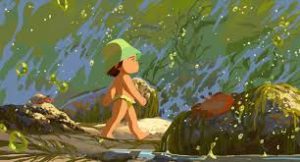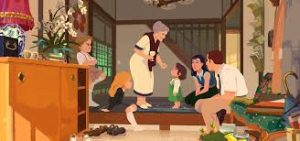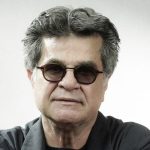A Conversation with Maïlys Vallade & Liane-Cho Han (LITTLE AMÉLIE OR THE CHARACTER OF RAIN)

Maïlys Vallade and Liane-Cho Han’s Little Amélie or the Character of Rain is a 71-minute animated wonder that captures the world through the eyes of a two-year-old girl who believes she’s God. Adapted from Belgian novelist Amélie Nothomb’s autobiographical novel, the film follows young Amélie as she awakens to consciousness in 1960s Japan. Amélie erupts into sentience after tasting Belgian white chocolate from her grandmother and so begins an impressionistic coming-of-age story told through vignettes that balance the joy of discovery with the pain of grief, rendered in a soft, rotoscope-like digital animation style that transforms ordinary moments into awe inspiring beauty. Working with artistic director Aiden Noël and a tight-knit creative family, Vallade and Han crafted their film over seven years. With influences ranging from Studio Ghibli’s Grave of the Fireflies to Princess Mononoke, the film is recommendable to the whole family. It premiered at TIFF 2025 and opened in select theaters October 31st via GKIDS before expanding nationwide November 7th.
Hammer to Nail: Thank you guys so much for taking the time to speak with me. I thought the movie was so beautiful. I have been telling everybody about it since I saw it. I’d love to discuss your collaboration first. How do you guys divide directorial responsibilities, or do you divide any? What does each of you bring to the creative partnership?
Maïlys Vallade: We have known each other for many years. We worked together as storyboarders. We debuted on The Little Prince many years ago. We worked with the director just before on Long Way North and Calamity. Together we made some storyboards. But yes, for this movie, we had a big challenge. The adaptation of this story was really difficult and took a long time. We began this adventure seven years ago and we wrote and rewrote for five years, I think. Then we were in a situation to enter production and do the movie in 14 months.
All our graphic family too, with Aiden Noël, our artistic director and co-screenwriter—he is very important in the process. We really wrote the definitive version together with Aiden to have a very precise script, word by word. But it was so difficult that we wrote again until the end of the movie, in post-production. It was a huge undertaking. So yes, we had to divide our positions in the movie. I was, for my part, lead director, narrative director, and I was mastering the global vision of the movie with the storyboard, animatic voice & sound, music direction etc.
Liane-Cho Han: As Maïlys said, because of this hectic rhythm, at some point the team started before we finished the animatic. Since the storyboard was also very rough, we had to be sure that the team understood the emotions of the film. Even though we’ve known them for a very long time, the precision of the emotion was so tight that we had to be sure that everyone was on the same page. I had to take care of the team. They needed someone to brief them. Everything moved so quickly once we started it was really like a race.
MV: We know each other very well. We don’t have to discuss a lot because we are on the same page.
LCH: We have this common strength that we love to be close to the character in the way we frame it, and to be sure that we are in their feeling, in their empathy, that point of view, and to communicate as much as possible the emotion to the audience without it being overbearing. That’s this common strength that really unites us as well to do this very emotional movie, because this movie is principally about emotion, more than impressive visuals. Of course, you have some impressive moments. But it’s about feelings, emotion, perception, through the gaze of this two-and-a-half-year-old girl.

A still from LITTLE AMÉLIE OR THE CHARACTER OF RAIN
MV: In every step of this process, we had huge challenges that could have stopped the movie every time. We had a big challenge to cut 20 minutes from 86 minutes of the movie. So it was really difficult for us just to compress the movie a lot. It’s easier when we have the two of us.
LCH: This movie is also the fruit of a very huge collaborative work with this amazing artistic family that’s worked with us for so many years. Everyone has brought a lot of things, a lot of ideas, to make sure that this movie has the right feeling, all those childhood memories. It was really the result of this really good collaboration, this team, this family, and each other.
HTN: You both cited Grave of the Fireflies and Princess Mononoke as key influences. So beyond aesthetics, how have those films shaped your philosophy about what animation can accomplish emotionally?
MV: To be able to speak about difficult subjects in a surrealistic way, but still with distance. It’s that ability. We love the ambiguity and surrealism
LCH: One of the best compliments we’ve received from the audience is when they say that when we watch the movie, we forget that we watch animation. We watch a real movie with mature, strong emotion. Just like when we watch Grave of the Fireflies, we just forget its animation because we’re so connected as a human, as a real human, with those characters. Even if they are drawn, we see them as real characters, real people, just like us. That’s really the beauty of it.
MV: We love to be close with the characters. So we love to be really sensorial. I think in this movie, it’s the same thing, this research of sensoriality.
HTN: I feel like a scene that really epitomizes that is the sequence where Nishio-san explains the bombing through the rice cooker. It’s such a fascinating and amazing moment. What was important to you in crafting that sequence? Talk about depicting trauma and war for a family audience in this way.
MV: In the book, when you read it for the first time, it’s really the scene that grabs you. In the book, it’s very gruesome and Amélie actually wants to know more of the gruesome details about it. We couldn’t do it that way in the movie. We also wanted to keep our distance. We have a lot of respect because we are not Japanese ourselves. So that’s not our experience. That was kind of a good coincidence that Nishio-san, the caretaker, is in the kitchen, that’s her place, her location. So that was ideal to build that sequence.
LCH: We needed to have as much respect as possible, not making something too graphic, too impressive, because we’re talking about war, and also not to minimize the gravity of what happened. So we decided to do this scene that way, but still with those sound effects, the way we frame as well, that illustrates what she’s saying. For example, when she pours the rice and it covers her face like she’s buried in the earth. So we still try to find some images that tell the story, but with the sound effects, not with some real war sounds, but still to enhance the reality, to push more, to be sure that we are in Amélie’s point of view during that moment.
MV: In the beginning we had sounds like bombing and playing like in the real world. It was a debate whether to do it in flashback or not. But the most intimate and the most respectful was the better way for us. Little by little, we kept lessening what would be perceived as too much voyeurism. To be really respectful of Nishio-san at this time when she was cooking.
HTN: I’d love to talk about that original book and the adaptation process. How did you decide what to include and exclude from the novel? The press kit mentions having to let go of aspects you were attached to, for example, the relationship with her father, Patrick.

A still from LITTLE AMÉLIE OR THE CHARACTER OF RAIN
MV: It was the biggest regret for us. The father, we love the father, and the very special relation with Japan. So yeah, it was a huge question. But we had no time to develop all the stories from the book. It was a big Tetris. We had all those scenes and really had to find what we wanted to say with the movie.
Yes, the biggest axis was the relationship between Nishio-san and Amélie. We really wanted to rest around the theme of death. So we chose scenes like the celebration of Obon. It’s not in the book, but we really tried to stretch the rubber band of the relationship.
Voiceover was a big challenge to express the naivety and singularity of Amélie, and also the manner to show how a little child sees the world from her point of view. To go in a way she’s going to go and check out things one after the other, like the way she does as a little child, in a chaotic way to stay in her perception.
LCH: It’s a mix of all these parameters that we had to balance. The film is for grown-ups and children. We have two layers of understanding in the movie, and that was the biggest challenge. Maybe for me, as an anecdote, my biggest regret is the use of the two languages, Japanese and French. But luckily, we have this amazing music composer, Marie Fouquard, who’s actually Japanese, and she makes some really beautiful songs.
But it’s true, I mean, we have made a lot of sacrifices from the book. But overall, we wanted to be sure that the movie tells this transition, this evolution from when she believes she’s in the center of the universe until she realizes that she’s actually part of it.
This dissolution, this grief, has to build this arc of her emotional state to really make sure that she goes through that transition. Through the importance of the relationship she has with Nishio-san and through Japan post-World War II,
MV: We left a few things like the radio where there’s an announcer that talks about flooding, which is something that was related to the father’s story in the book. little remnants that stayed from the story, even though it’s not very obvious were fun to add
LCH: We just left some details in the film. There are clues.
– Jack Schenker (@YUNGOCUPOTIS)











